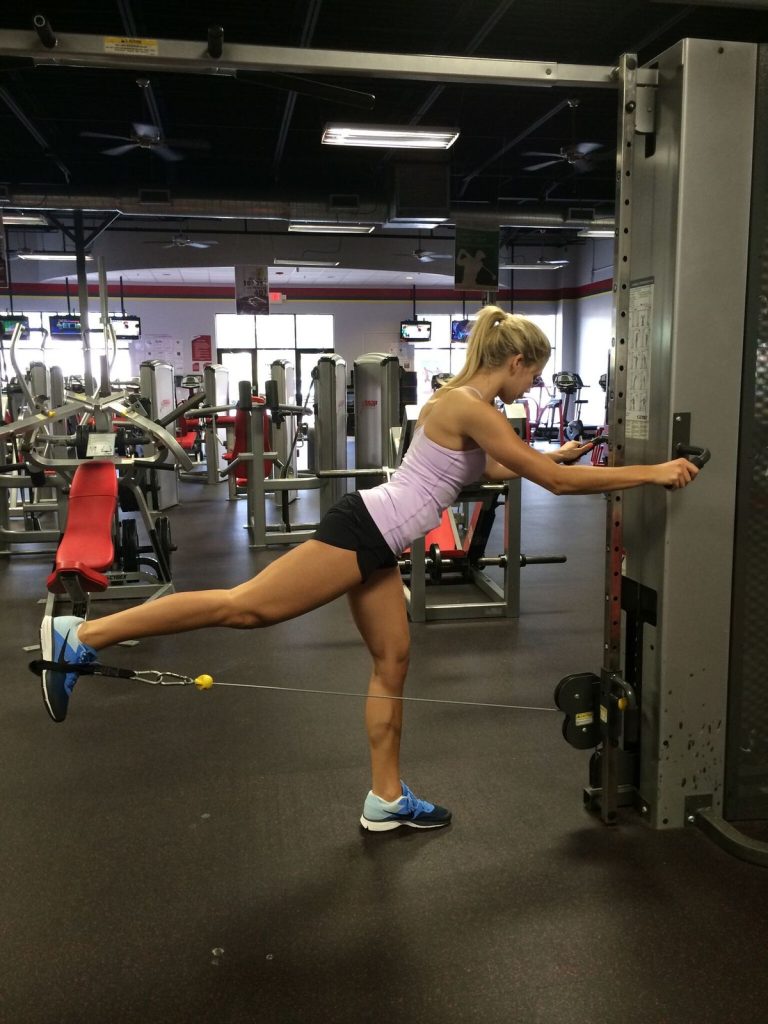4 de November de 2025
Cable Kickbacks: Exercise Guide, Tips and Benefits
Cable kickbacks are one of the most effective isolation exercises for targeting the glutes. By using a cable machine, athletes can maintain constant tension throughout the movement, making it more efficient than bodyweight-only variations. For coaches, cable kickbacks are a valuable addition to Strength and Conditioning programs, as they build glute strength, improve hip stability, and support performance in running, jumping, and lifting.
What Are Cable Kickbacks?
Cable kickbacks are a lower-body isolation exercise performed on a cable machine. With the resistance attached to one ankle, the athlete kicks the leg backward in a controlled motion, targeting the gluteus maximus and supporting muscles.
Unlike free-weight or bodyweight glute movements, the cable machine provides constant resistance through the full range of motion. This makes cable kickbacks ideal for building muscle endurance and improving strength in a highly focused way.
How to Do Cable Kickbacks Properly
- Set Up: Attach an ankle cuff to a low cable pulley and fasten it securely around your ankle.
- Positioning: Stand facing the machine, holding the frame for stability.
- Engage the Core: Keep your torso upright and brace your abs to avoid arching the back.
- Kick Back: Extend your leg straight back in a controlled motion, squeezing the glute at the top.
- Return Slowly: Lower your leg with control until it’s back in line with the supporting leg.
- Repetitions: Perform 10–15 reps per side, 2–3 sets, depending on your training phase.
👉 Coaching tip: Avoid swinging the leg or leaning forward excessively. The focus should remain on controlled glute activation rather than momentum.

Muscles Worked by Cable Kickbacks
- Gluteus maximus – primary muscle targeted
- Gluteus medius and minimus – for stabilization
- Hamstrings – assist in hip extension
- Core stabilizers – help maintain posture during the exercise
Benefits of Cable Kickbacks
- Glute Isolation: Directly targets the glutes more effectively than many compound lifts.
- Constant Tension: Cable resistance keeps muscles engaged through the entire movement.
- Hip Stability: Strengthens muscles that stabilize the pelvis during athletic movements.
- Sport Transfer: Improves sprinting speed, jumping power, and change of direction.
- Injury Prevention: Helps reduce imbalances that often cause hamstring or lower back issues.
- Progressive Overload: Easy to increase resistance by adjusting the weight stack.
Integrating cable kickbacks with velocity-based training and tracking performance via a load-velocity profile allows coaches to monitor glute development while managing fatigue in their athletes.

Common Mistakes to Avoid
- Overarching the back: Shifts tension away from the glutes and risks injury.
- Swinging the leg: Using momentum reduces activation and control.
- Too much weight: Leads to poor form and excessive compensation.
- Leaning forward excessively: Involves the lower back rather than isolating the glutes.
- Not squeezing at the top: Missing the peak contraction limits effectiveness.
Variations of Cable Kickbacks
- Kneeling Cable Kickbacks: Performed on all fours for added stability.
- Standing Straight-Leg Kickbacks: Increases hamstring recruitment.
- Diagonal Kickbacks: Kick the leg slightly out to the side to target glute medius.
- Single-Arm Support Kickbacks: Forces more balance and core activation.
- Banded Kickbacks: Resistance bands as an alternative to cable machines.
How to Include Cable Kickbacks in Your S&C Workout
- Warm-Up Activation: Light sets to fire up glutes before heavy squats or deadlifts.
- Accessory Work: Include after compound lifts to directly target glutes.
- Hypertrophy Training: Use moderate weight and high reps (12–15) for muscle growth.
- Athletic Performance: Integrate into circuits to strengthen hip extension for sprinting.
- Rehabilitation: Excellent for restoring hip strength after injury.
Cable kickbacks are a versatile tool for both athletes and general strength enthusiasts. When programmed correctly, they complement broader Strength and Conditioning goals by improving power, stability, and resilience.
FAQs About Cable Kickbacks
What muscles do cable kickbacks work?
Cable kickbacks primarily target the gluteus maximus, while also engaging the gluteus medius, hamstrings, and core muscles for stability.
Are cable kickbacks any good?
Yes, they are one of the best exercises for isolating and strengthening the glutes. They provide constant tension, which is ideal for muscle growth and activation.
How to do a proper cable kickback?
Focus on a slow, controlled kick backward with your torso upright and core engaged. Avoid swinging the leg and squeeze the glute at the top for maximum benefit.
Are cable kickbacks bad for your back?
Not if performed correctly. Keeping the spine neutral and avoiding excessive arching prevents lower back strain. Problems usually occur when too much weight is used or form is compromised.
Why am I not feeling cable kickbacks in my glutes?
If you don’t feel the glutes working, you may be using too much weight, relying on momentum, or not fully contracting at the top. Reduce the load and focus on controlled movement.
How heavy should cable kickbacks be?
Choose a weight that allows 10–15 controlled reps with good form. Too heavy will compromise technique, while too light won’t provide enough stimulus for progress.
What can replace cable kickbacks?
Resistance band kickbacks, glute bridges, hip thrusts, or donkey kicks can serve as alternatives when a cable machine isn’t available.
